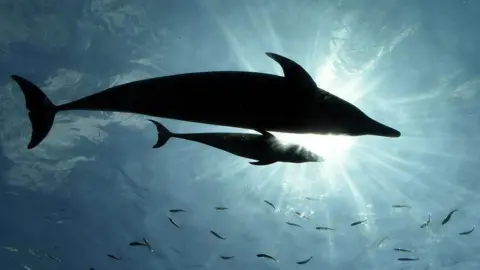Lonely dolphin looking for mate blamed for attacks
 Getty Images
Getty ImagesDolphins may be portrayed as friendly creatures in story books, but residents at a seaside town in Japan have been sternly advised to stay away from them.
The warning in the town of Mihama, Fukui prefecture, gets more forbidding: “They can bite you with their sharp teeth and cause you to bleed, or… drag you into the sea, which could be life-threatening”.
For the third year running, there has been a spike in dolphin attacks in Fukui, which marine experts have attributed to one lonely, sexually frustrated bottlenose dolphin.
Eighteen people have been injured this summer at beaches in the prefecture, the coast guard say, including an elementary school student whose finger required at least 20 stitches.
At least six people were injured last year, including a swimmer left with broken ribs, and one in 2022.
Tadamichi Morisaka, a cetology professor at Japan’s Mie University, said the dorsal fin of a dolphin spotted bitting a man’s fingers at a beach in Tsuruga – a port city next to Mihama – matched those of a 2.5m long dolphin observed off the coast of Fukui last year.
The dorsal fin is like a dolphin’s fingerprint, as each has distinctive notches, ridges and pigmentation.
“It is reasonable to assume that it is the same individual, as the wounds on the tail fin are similar to those of the dolphins seen off the coast last year, and it is rare for dolphins, which normally move in groups, to be alone for such a long time,” Prof Morisaka told NHK.
He added that male bottlenose dolphins communicate by “play-biting each other”. “They are not trying to injure people, but are using the dolphins’ way of communication with people,” he said.
Others have suggested various theories on why the same creature may be behind these attacks – including a desire for sex.
“Bottlenose dolphins are highly social animals and this sociality can be expressed in very physical ways,” said Dr Simon Allen, a biologist and principal investigator with the Shark Bay Dolphin Research project.
“Just as in humans and other social animals, hormonal fluctuations, sexual frustration or the desire to dominate might drive the dolphin to injuring the people it interacts with. Since they are such powerful animals, this can lead to serious injury in humans,” he said.
Dr Allen added that the dolphin may have been “ostracised from its own community and be seeking alternative companionship”.
Dr Matthias Hoffmann-Kuhnt, a marine mammal expert at the National University of Singapore said the dolphin could also be acting in its own defence.
“Most of the time, in my experience, this is more a defensive behaviour when humans get to close to these dolphins and do not know how to conduct themselves,” he said, referring to reports of people trying to ride the animals or sticking their fingers into the dolphins’ blowholes.
“Thus it is no wonder that the animals then turn aggressive or at least protective against humans in the water,” he said.
It could also be that the dolphin previously had a bad encounter with a human being and now projects that relationship onto other humans it encounters, Dr Hoffmann-Kuhnt said.
“They have good memory, similar to elephant who will remember who mistreated them before,” he said.
Dolphin attacks can be fatal. In 1994, a dolphin in Brazil attacked two male swimmers who tried to ride it, killing one and injuring the other. The dolphin, nicknamed Tião, was believed to have injured at least 22 people before that.
Additional reporting by Chika Nakayama in Tokyo






